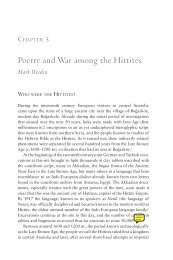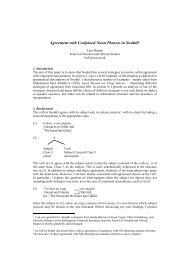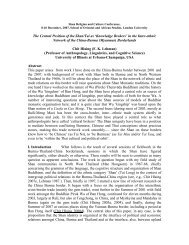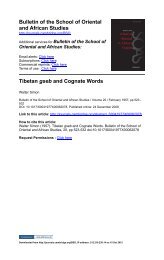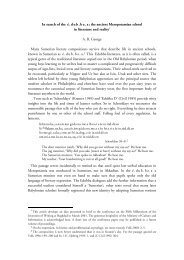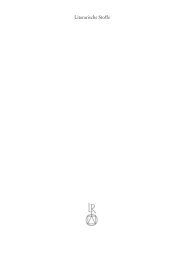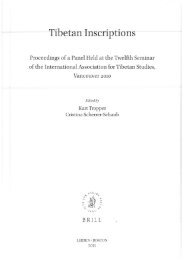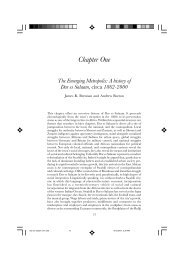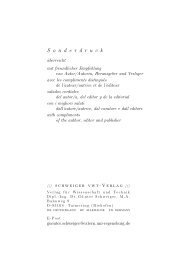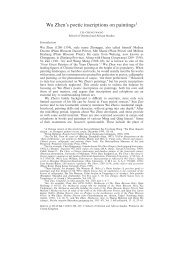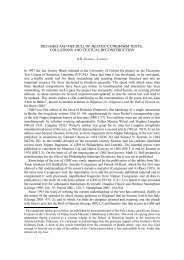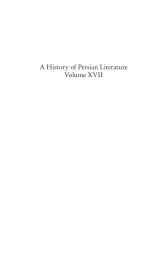- Page 1 and 2: Journal of Language Contact Evoluti
- Page 3 and 4: Journal of Language Contact (JLC) E
- Page 5 and 6: Journal of Language Contact. Evolut
- Page 7 and 8: Journal of Language Contact. Evolut
- Page 9 and 10: Journal of Language Contact. Evolut
- Page 11 and 12: MULTILINGUALISM AND LANGUAGE CONTAC
- Page 13 and 14: Multilingualism and language contac
- Page 15 and 16: Multilingualism and language contac
- Page 17 and 18: Multilingualism and language contac
- Page 19 and 20: Multilingualism and language contac
- Page 21 and 22: Multilingualism and language contac
- Page 23 and 24: I. CONTACT AND MULTILINGUALISM AS A
- Page 25 and 26: THE MANDE AND ATLANTIC GROUPS OF NI
- Page 27 and 28: The Mande and Atlantic groups of Ni
- Page 29 and 30: The Mande and Atlantic groups of Ni
- Page 31 and 32: The Mande and Atlantic groups of Ni
- Page 33: The Mande and Atlantic groups of Ni
- Page 37 and 38: The Mande and Atlantic groups of Ni
- Page 39 and 40: The Mande and Atlantic groups of Ni
- Page 41 and 42: The Mande and Atlantic groups of Ni
- Page 43 and 44: The Mande and Atlantic groups of Ni
- Page 45 and 46: The Mande and Atlantic groups of Ni
- Page 47 and 48: The Mande and Atlantic groups of Ni
- Page 49 and 50: The Mande and Atlantic groups of Ni
- Page 51 and 52: The Mande and Atlantic groups of Ni
- Page 53 and 54: The Mande and Atlantic groups of Ni
- Page 55 and 56: The Mande and Atlantic groups of Ni
- Page 57 and 58: ANALYSE SOCIOLINGUISTIQUE DU CONTAC
- Page 59 and 60: Analyse sociolinguistique du contac
- Page 61 and 62: Analyse sociolinguistique du contac
- Page 63 and 64: Analyse sociolinguistique du contac
- Page 65 and 66: Analyse sociolinguistique du contac
- Page 67 and 68: Analyse sociolinguistique du contac
- Page 69 and 70: Analyse sociolinguistique du contac
- Page 71 and 72: Analyse sociolinguistique du contac
- Page 73 and 74: Analyse sociolinguistique du contac
- Page 75 and 76: Analyse sociolinguistique du contac
- Page 77 and 78: Analyse sociolinguistique du contac
- Page 79 and 80: II. STRUCTURAL OUTCOMES OF LANGUAGE
- Page 81 and 82: MORPHOLOGICAL CONSEQUENCES OF MANDE
- Page 83 and 84: Morphological consequences of Mande
- Page 85 and 86:
Morphological consequences of Mande
- Page 87 and 88:
Morphological consequences of Mande
- Page 89 and 90:
Morphological consequences of Mande
- Page 91 and 92:
Morphological consequences of Mande
- Page 93 and 94:
Morphological consequences of Mande
- Page 95 and 96:
Morphological consequences of Mande
- Page 97 and 98:
Impact of Pular on the Kakabe langu
- Page 99 and 100:
Impact of Pular on the Kakabe langu
- Page 101 and 102:
Impact of Pular on the Kakabe langu
- Page 103 and 104:
4. Vocabulary Impact of Pular on th
- Page 105 and 106:
Impact of Pular on the Kakabe langu
- Page 107 and 108:
Pular Kakabe konondol kɔńɔndɔlu
- Page 109 and 110:
Impact of Pular on the Kakabe langu
- Page 111 and 112:
Impact of Pular on the Kakabe langu
- Page 113 and 114:
Impact of Pular on the Kakabe langu
- Page 115 and 116:
Impact of Pular on the Kakabe langu
- Page 117 and 118:
III. DEVELOPING METHODOLOGIES AND P
- Page 119 and 120:
SOME METHODOLOGICAL PROBLEMS IN THE
- Page 121 and 122:
Some methodological problems in the
- Page 123 and 124:
Some methodological problems in the
- Page 125 and 126:
Some methodological problems in the
- Page 127 and 128:
Some methodological problems in the
- Page 129 and 130:
Some methodological problems in the
- Page 131 and 132:
Some methodological problems in the
- Page 133 and 134:
Some methodological problems in the
- Page 135 and 136:
Some methodological problems in the
- Page 137 and 138:
Some methodological problems in the
- Page 139 and 140:
Some methodological problems in the
- Page 141 and 142:
LANGUAGE CONTACT AND CHANGE: A LOOK
- Page 143 and 144:
Language contact and change 133 edu
- Page 145 and 146:
Language contact and change 135 Map
- Page 147 and 148:
Language contact and change 137 rel
- Page 149 and 150:
Language contact and change 139 The
- Page 151 and 152:
Language contact and change 141 giv
- Page 153 and 154:
Language contact and change 143 As
- Page 155 and 156:
Language contact and change 145 Fig
- Page 157 and 158:
Language contact and change 147 sho
- Page 159 and 160:
Language contact and change 149 syn
- Page 161 and 162:
Language contact and change 151 Hei
- Page 163 and 164:
IV. DEFINING COMMUNITIES, LANGUAGES
- Page 165 and 166:
LANGUAGE AND IDENTITY IN FLUX: IN S
- Page 167 and 168:
Language and identity in flux: in s
- Page 169 and 170:
Language and identity in flux: in s
- Page 171 and 172:
Language and identity in flux: in s
- Page 173 and 174:
Language and identity in flux: in s
- Page 175 and 176:
Language and identity in flux: in s
- Page 177 and 178:
Language and identity in flux: in s
- Page 179 and 180:
Language and identity in flux: in s
- Page 181 and 182:
Language and identity in flux: in s
- Page 183 and 184:
Language and identity in flux: in s
- Page 185 and 186:
Introduction THE CASAMANCE AS AN AR
- Page 187 and 188:
Casamance as an area of intense lan
- Page 189 and 190:
Casamance as an area of intense lan
- Page 191 and 192:
Casamance as an area of intense lan
- Page 193 and 194:
Casamance as an area of intense lan
- Page 195 and 196:
Casamance as an area of intense lan
- Page 197 and 198:
Casamance as an area of intense lan
- Page 199 and 200:
Casamance as an area of intense lan
- Page 201 and 202:
Casamance as an area of intense lan
- Page 203 and 204:
c) si-limo ‘orange tree’ d) mu-
- Page 205 and 206:
Casamance as an area of intense lan
- Page 207 and 208:
Casamance as an area of intense lan
- Page 209 and 210:
Casamance as an area of intense lan
- Page 211 and 212:
Casamance as an area of intense lan
- Page 213 and 214:
V. MULTILINGUALISM IN WRITING AND I
- Page 215 and 216:
MULTILINGUISME ET PLURIGRAPHIE DANS
- Page 217 and 218:
Multilinguisme et plurigraphie dans
- Page 219 and 220:
Multilinguisme et plurigraphie dans
- Page 221 and 222:
Multilinguisme et plurigraphie dans
- Page 223 and 224:
Multilinguisme et plurigraphie dans
- Page 225 and 226:
Multilinguisme et plurigraphie dans
- Page 227 and 228:
Multilinguisme et plurigraphie dans
- Page 229 and 230:
Multilinguisme et plurigraphie dans
- Page 231 and 232:
Multilinguisme et plurigraphie dans
- Page 233 and 234:
Multilinguisme et plurigraphie dans
- Page 235 and 236:
Multilinguisme et plurigraphie dans
- Page 237 and 238:
Multilinguisme et plurigraphie dans
- Page 239 and 240:
Vœux électroniques plurilingues:
- Page 241 and 242:
Vœux électroniques plurilingues:
- Page 243 and 244:
Vœux électroniques plurilingues:
- Page 245 and 246:
Vœux électroniques plurilingues:
- Page 247 and 248:
Vœux électroniques plurilingues:
- Page 249 and 250:
Vœux électroniques plurilingues:
- Page 251 and 252:
Vœux électroniques plurilingues:
- Page 253 and 254:
Vœux électroniques plurilingues:
- Page 255 and 256:
Vœux électroniques plurilingues:
- Page 257 and 258:
L’INTRODUCTION DES LANGUES NATION
- Page 259 and 260:
L’introduction des langues nation
- Page 261 and 262:
L’introduction des langues nation
- Page 263 and 264:
L’introduction des langues nation
- Page 265 and 266:
L’introduction des langues nation
- Page 267 and 268:
L’introduction des langues nation
- Page 269 and 270:
L’introduction des langues nation
- Page 271 and 272:
L’introduction des langues nation
- Page 273 and 274:
L’introduction des langues nation
- Page 275 and 276:
L’introduction des langues nation
- Page 278 and 279:
268 Ingse Skattum Dumestre, Gérard
- Page 280 and 281:
270 Ingse Skattum Tamari, Tal. 2009
- Page 282 and 283:
influence of the second largest lan
- Page 284 and 285:
langue et développe un nombre d’
- Page 286 and 287:
276 Petitjean Cécile Université d



